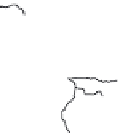Environmental Engineering Reference
In-Depth Information
Unfortunately, riparian and wetland communities have usually been cut down or
drained to provide a greater area for agricultural production. Riparian vegetation
and wetlands can sometimes be restored to a seminatural state. An alternative is
'treatment wetlands', which are constructed, planted and fl ow-controlled to maxi-
mize removal of pollutants from wastewater. How much of a difference might
wetland restoration/construction be expected to make? It seems that at a maximum,
wetlands in temperate areas might remove 1000-3000 kg ha
−1
yr
−1
of nitrogen and
60-100 kg ha
−1
yr
−1
of phosphorus from water fl owing through them. Estimates for
stream catchment areas in southern Sweden, which are a major source of nitrate
enrichment of the Baltic Sea, indicate that to remove 40% of the nitrogen currently
fi nding its way into the sea, a system of wetlands covering about 5% of the total
land area would need to be recreated (Figure 9.13).
9.7.4
Managing lake
eutrophication
Lake eutrophication, where phosphorus is often the principal culprit, can be reversed
by either chemical or biological means. In the fi rst case, reduction of P inputs may
be combined with an intervention such as chemical treatment to immobilize P in
the sediment
-
in many cases recovery to a more oligotrophic state occurs within
10 -15 years (Jeppesen et al., 2005). In essence, this is
bottom-up
control (Box 9.1)
of nutrient availability, which reduces phytoplankton productivity (increasing water
clarity) and successively reduces biomass in the higher trophic levels of zooplankton
and fi sh.
The aim of biological control
-
known as
biomanipulation -
is also to reduce phy-
toplankton density and increase water clarity, but it does this via an increase in
grazing by zooplankton that comes about after the biomass of zooplanktivorous fi sh
has been actively reduced (by fi shing them out or by increasing piscivorous fi sh
biomass). The outcome is the same, but the process by which it is achieved is
top-
down
control of a cascade in the food web.
Lathrop et al. (2002) attempted to biomanipulate the relatively large and deep
eutrophic Lake Mendota in Wisconsin, USA. Their approach was to increase the
Fig. 9.13
The locations
of 148 wetlands under
construction along
tributaries of the
Rönneå River in
southern Sweden. If
these are built to
occupy 5% of the total
land area, a 40%
reduction can be
expected in agricultural
nitrogen input to the
Baltic Sea. (From
Verhoeven et al., 2006,
based on Arheimer &
Wittgren, 2002.)
N
10 km




































































































Search WWH ::

Custom Search